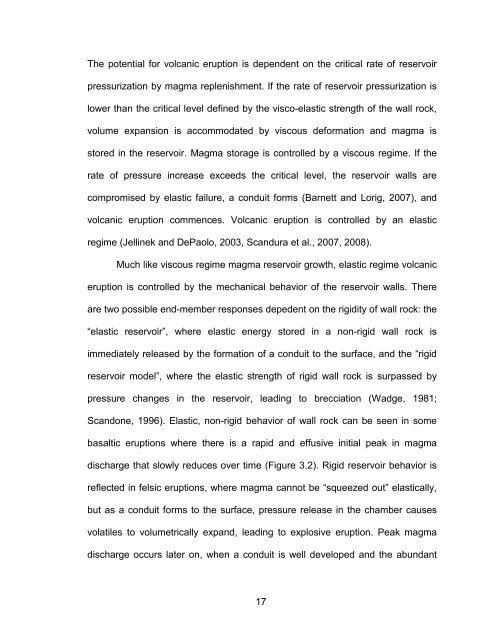Create successful ePaper yourself
Turn your PDF publications into a flip-book with our unique Google optimized e-Paper software.
The potential for volcanic eruption is dependent on the critical rate <strong>of</strong> reservoir<br />
pressurization by magma replenishment. If the rate <strong>of</strong> reservoir pressurization is<br />
lower than the critical level defined by the visco-elastic strength <strong>of</strong> the wall rock,<br />
volume expansion is accommodated by viscous deformation and magma is<br />
stored in the reservoir. Magma storage is controlled by a viscous regime. If the<br />
rate <strong>of</strong> pressure increase exceeds the critical level, the reservoir walls are<br />
compromised by elastic failure, a conduit for<strong>ms</strong> (Barnett and Lorig, 2007), and<br />
volcanic eruption commences. Volcanic eruption is controlled by an elastic<br />
regime (Jellinek and DePaolo, 2003, Scandura et al., 2007, 2008).<br />
Much like viscous regime magma reservoir growth, elastic regime volcanic<br />
eruption is controlled by the mechanical behavior <strong>of</strong> the reservoir walls. There<br />
are two possible end-member responses depedent on the rigidity <strong>of</strong> wall rock: the<br />
“elastic reservoir”, where elastic energy stored in a non-rigid wall rock is<br />
immediately released by the formation <strong>of</strong> a conduit to the surface, and the “rigid<br />
reservoir model”, where the elastic strength <strong>of</strong> rigid wall rock is surpassed by<br />
pressure changes in the reservoir, leading to brecciation (Wadge, 1981;<br />
Scandone, 1996). Elastic, non-rigid behavior <strong>of</strong> wall rock can be seen in some<br />
basaltic eruptions where there is a rapid and effusive initial peak in magma<br />
discharge that slowly reduces over time (Figure 3.2). Rigid reservoir behavior is<br />
reflected in felsic eruptions, where magma cannot be “squeezed out” elastically,<br />
but as a conduit for<strong>ms</strong> to the surface, pressure release in the chamber causes<br />
volatiles to volumetrically expand, leading to explosive eruption. Peak magma<br />
discharge occurs later on, when a conduit is well developed and the abundant<br />
17
















